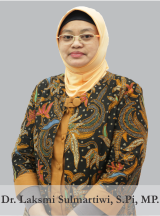Utilization of Green Mussel (Perna viridis) as A Lead Metal Pollutant Adorbent in Batik Dye Waste
Downloads
Lead (Pb) from batik dyeing waste that is thrown into the environment can pollute the environment so it needs processing before being thrown into the environment. The aim of this research is to determine the effect of green mussel shells as an adsorbent with different concentrations on reducing Pb heavy metal contamination in batik dyeing waste and to determine the optimal concentration of green mussel shells to reduce Pb heavy metal contamination in batik dyeing waste. The research method used was experimental with 4 treatments with different concentrations of green mussel shell ash as an adsorbent (0, 10, 20, and 30%). The results of the research showed that a green mussel shell ash concentration of 30% was the best concentration because it was able to reduce Pb levels in batik dyeing waste by 68.52%. Characterization of green mussel shell ash includes average pore radius (10.674 nm), total pore volume (0.005 cc/g), and surface area (0.969 m2/g).
Anugerah A. S. (2015). Pemanfaatan limbah cangkang kerang bulu sebagai adsorben untuk menjerap logam kadmium (II) dan Timbal (II). Jurnal Teknik Kimia USU, 4(3):40-45.
Awual, M. R., & Hasan, M. M. (2014). A novel fine-tuning mesoporous adsorbent for simultaneous lead (II) detection and removal from wastewater. Sensors and Actuators B: Chemical, 202:395-403.
Chairunisa, A. N. (2022). Sintesis komposit CaO/Fe3O4 dari cangkang kerang darah (Anadara granosa) dan aplikasinya sebagai adsorben zat warna Congo Red. Skripsi. Palembang: Universitas Sriwijaya.
Charlena, Purwaningsih, H., & Tina, R. (2008). Pencirian dan uji aktivitas katalitik zeolit alam teraktivasi. Jurnal Riset Kimia, 1(2):107-116.
Ferawati, F., Trisnawati, D., Zam, R., & Hendra, H. (2023). Edukasi melalui workshop pembuatan kain ikat celup bagi siswa MAN 3 Padangpanjang. Jurnal Abdidas, 3(4):238-249.
Fu, J., Zhang, J., Jin, C., Wang, Z., Wang, T., Cheng, X., & Ma, C. (2020). Effects of temperature, oxygen and steam on pore structure characteristics of coconut husk activated carbon powders prepared by one-step rapid pyrolysis activation process. Bioresource Technology, 310(123413):1-8.
Grozdov, D., & Zinicovscaia, I. (2023). Mesoporous materials for metal-laden wastewater treatment. Materials 16(5864):1-16.
Hartati, I., Riwayati, I., & Kurniasari, L. (2011). Potensi xanthate pulpa kopi sebagai adsorben pada pemisahan ion timbal dari limbah industri batik. Momentum, 7(2):25-30.
Ifa, L., Akbar, M., Ramli, A. F., & Wiyani, L. (2018). Pemanfaatan cangkang kerang dan cangkang kepiting sebagai adsorben logam Cu, Pb, dan Zn pada limbah industri pertambangan emas. Journal of Chemical Process Engineering, 3(1):33-37.
Ivontianti, W. D., Khairi, S., Devitasari, R., & Yusup, Y. (2022). Pemanfataan cangkang keong susuh kura (Sulcospira Testudinaria) sebagai adsorben untuk menyerap logam besi (Fe) di perairan dengan kajian variasi suhu kalsinasi adsorben. Jurnal Teknologi Lingkungan Lahan Basah, 10(1):38-47.
Jannah, M. (2022). Pemanfaatan cangkang kerang langkitang (Faunus ater) sebagai biosorben untuk menyerap logam berat timbal (Pb) di Sungai Krueng Reuleung. Thesis. Banda Aceh: Universitas Islam Negeri Ar-Raniry.
Kurniati, Y., Septiani, E. L., Prastuti, O. P., Purnomo, V., Dewi, S. S. N., & Mahmuddin, I. (2020). Pengaruh waktu terhadap temperatur aktivasi dari kulit pisang (Musa paradisiaca L.) dalam pembuatan katalis. Jurnal Teknik Kimia dan Lingkungan, 4(1):33-37.
Lam, K. F., Yeung, K. L., & McKay, G. (2006). A rational approach in the design of selective mesoporous adsorbent. Langmuir, 22(23):9632-9641.
Liang, Y., Zhao, B., & Yuan, C. (2022). Adsorption of atrazine by Fe-Mn-modified: The dominant mechanism of π–π interaction and pore structure. Agronomy, 12(3097):1-15.
Liu, X., Zhou, L., Fu, X., Sun, Y., Su, W., & Zhou, Y. (2007). Adsorption and regeneration study of the mesoporous adsorbent SBA-15 adapted to the capture/separation of CO2 and CH4. Chemical Engineering Science, 62(4):1101-1110.
Malau, N. D. & Adinugraha, F. (2020). Penentuan suhu kalsinasi optimum CaO dari cangkang telur bebek dan cangkang telur burung puyuh. EduMatSains: Jurnal Pendidikan, Matematika, dan Sains, 4(2):193-202.
Mandal, G. C., Nandi, A. M., & Cakraborty, A. (2022). The toxic effect of lead on human health – a review. Journal of the Auxological Society, 3:1-11.
Manullang, P. & Herlinawati. (2023). Preparation and characterization of adsorbents from oil palm fronds coated with nanochitosan from green mussel shells. Indonesian Journal of Advanced Research, 2(10):1373-1386.
Nadhilah, F., Nurhayati, & Handayani, L. (2022). Gambaran histologi usus ikan nila (Oreochromis niloticus) yang diberikan pakan dengan campuran adsorben cangkang langkitang (Faunus ater). Jurnal TILAPIA (Ilmu Perikanan dan Perairan), 3(2):51-60.
Nasution, J. H., & Iriany. (2015). Pembuatan adsorben dari cangkang kerang bulu yang diaktivasi secara termal sebagai pengadsorpsi fenol. Jurnal Teknik Kimia USU, 4(4): 51-57.
Onaola, B. M., Utubira, Y., & Manuhuttu, J. B. (2020). Pilarisasi lempung alam Desa Ouw dengan Al2O3 sebagai adsorben zat warna metil orange. Molluca Journal of Chemistry Education, 10(1):63-71.
Padmiswari, A. A. I. M., Wulansari, N. T., & Indrawan, G. S. (2023). Pemanfaatan cangkang kerang darah (Anadara granosa) sebagai adsorben logam Pb pada perairan Serangan Bali. Jurnal Pendidikan Biologi, 8(1):80-87.
Prihatini, D. (2013). Persepsi pengrajin batik tentang penerapan self-help groups dalam rangka penguatan Sentra Industri Batik. Repository Universitas Jember. https://repository.unej.ac.id/handle/123456789/56234
Rahmawan, Z. R. (2019). Karakteristik CaCO3 dari hasil sintesis cangkang kerang darah sebagai alternatif terapi pada kerusakan tulang dengan berbagai variasi suhu. Skripsi. Surakarta: Universitas Sebelas Maret.
Rosyidah, S. & Ciptadi, F. (2019, Agustus). Pengembangan kain tenun gedog Tuban bertekstur dengan pewarna alam mahoni. e-Proceeding of Art and Design. Bandung: Universitas Telkom.
Thaib, A., Wati, E., Handayani, L., & Nurhayati. (2021). Pengaruh pemberian adsorben cangkang langkitang (Faunus ater) untuk mereduksi kadar amonia pada media budidaya benih ikan nila (Oreochromis niloticus). Jurnal TILAPIA (Ilmu Perikanan dan Perairan), 3(1):1-7.
Wang, Q., Jiang, F., Ouyang, X. K., Yang, L. Y., & Wang, Y. (2021). Adsorption of Pb (II) from aqueous solution by mussel shell-based adsorbent: Preparation, characterization, and adsorption performance. Materials, 14(741):1-17.
Wardani, D. A. K. (2022). Pengaruh pemanfaatan serbuk cangkang kerang hijau (Perna viridis L.) sebagai bahan substitusi sebagian semen terhadap kuat tekan dan kuat tarik belah beton. Skripsi. Yogyakarta: Universitas Islam Indonesia.
Copyright (c) 2024 Journal of Marine and Coastal Science

This work is licensed under a Creative Commons Attribution-NonCommercial-ShareAlike 4.0 International License.













